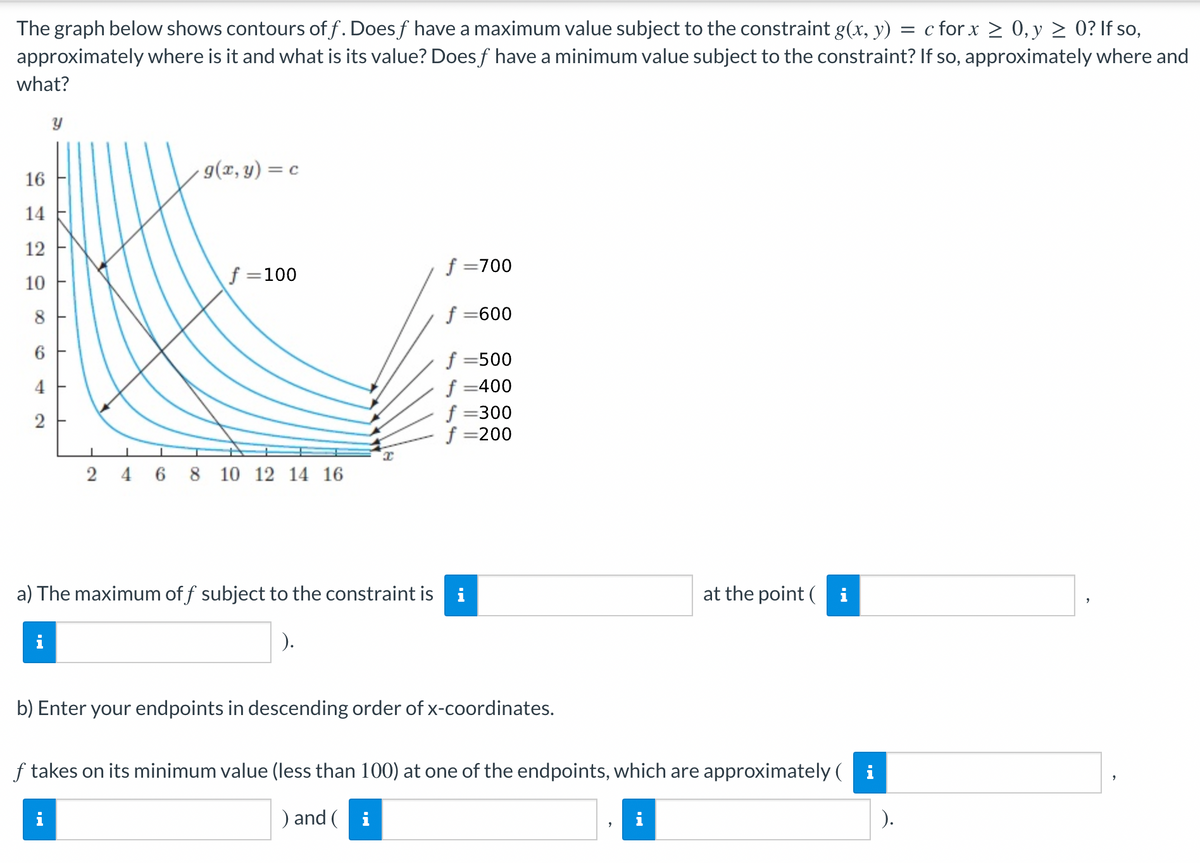The graph below shows contours of f. Does f have a maximum value subject to the constraint g(x, y) = c for x ≥ 0, y ≥ 0? If so, approximately where is it and what is its value? Does f have a minimum value subject to the constraint? If so, approximately where and what? 16 14 12 10 8 6 4 F 2 Y i J 2 g(x, y) = c i f = 100 46 8 10 12 14 16 x f = 700 f=600 a) The maximum of f subject to the constraint is i -500 f = 400 f =300 f=200 b) Enter your endpoints in descending order of x-coordinates. f takes on its minimum value (less than 100) at one of the endpoints, which are approximately (i ) and ( i ). at the point ( i i
The graph below shows contours of f. Does f have a maximum value subject to the constraint g(x, y) = c for x ≥ 0, y ≥ 0? If so, approximately where is it and what is its value? Does f have a minimum value subject to the constraint? If so, approximately where and what? 16 14 12 10 8 6 4 F 2 Y i J 2 g(x, y) = c i f = 100 46 8 10 12 14 16 x f = 700 f=600 a) The maximum of f subject to the constraint is i -500 f = 400 f =300 f=200 b) Enter your endpoints in descending order of x-coordinates. f takes on its minimum value (less than 100) at one of the endpoints, which are approximately (i ) and ( i ). at the point ( i i
Algebra & Trigonometry with Analytic Geometry
13th Edition
ISBN:9781133382119
Author:Swokowski
Publisher:Swokowski
Chapter11: Topics From Analytic Geometry
Section11.4: Plane Curves And Parametric Equations
Problem 3E
Related questions
Question

Transcribed Image Text:The graph below shows contours of f. Does f have a maximum value subject to the constraint g(x, y) = c for x ≥ 0, y ≥ 0? If so,
approximately where is it and what is its value? Does ƒ have a minimum value subject to the constraint? If so, approximately where and
what?
16
14
12
10
4
2
Y
T
g(x, y) =
i
= C
f = 100
2 4 6 8 10 12 14 16
x
f = 700
f =600
f =500
f=400
f =300
f=200
a) The maximum of f subject to the constraint is i
b) Enter your endpoints in descending order of x-coordinates.
at the point (
f takes on its minimum value (less than 100) at one of the endpoints, which are approximately (i
) and (i
).
Expert Solution
This question has been solved!
Explore an expertly crafted, step-by-step solution for a thorough understanding of key concepts.
This is a popular solution!
Trending now
This is a popular solution!
Step by step
Solved in 2 steps with 1 images

Recommended textbooks for you

Algebra & Trigonometry with Analytic Geometry
Algebra
ISBN:
9781133382119
Author:
Swokowski
Publisher:
Cengage

Algebra & Trigonometry with Analytic Geometry
Algebra
ISBN:
9781133382119
Author:
Swokowski
Publisher:
Cengage